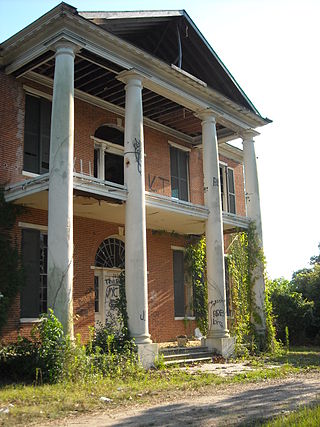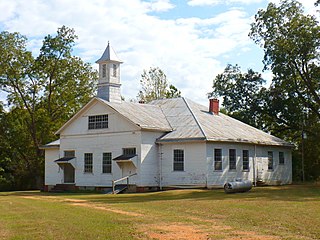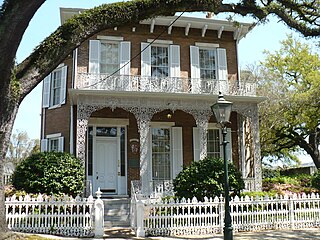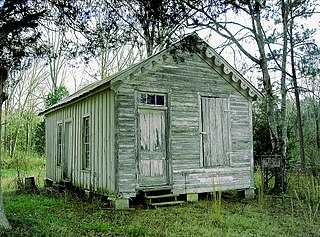
Gainesville is a town in Sumter County, Alabama, United States. Founded in 1832, it was incorporated in 1835. At the 2010 census the population was 208, down from 220. Confederate Lieutenant General Nathan Bedford Forrest surrendered his men near Gainesville on May 19, 1865, at the Civil War's end.

Arlington is a historic Federal style house and outbuildings in Natchez, Mississippi. The 55-acre (22 ha) property, which includes three contributing buildings, was listed on the National Register of Historic Places in 1973. It was further declared a National Historic Landmark in 1974. Following a fire that destroyed much of the main house, it was placed on Mississippi's 10 most endangered historic places for 2009 by the Mississippi Heritage Trust.

Prairie Mission, also known as the Prairie Mission School and Prairie Institute, was a historic African American school in the community of Prairie, Alabama. The school is the only survivor of the six original Presbyterian mission schools that once operated in Wilcox County. It was placed on the Alabama Register of Landmarks and Heritage on July 22, 1991 and subsequently on the National Register of Historic Places on October 29, 2001, due its significance to African American history.

The Goode–Hall House, also commonly known as Saunders Hall, is a historic plantation house in the Tennessee River Valley near Town Creek, Alabama. It was added to the National Register of Historic Places on October 1, 1974, due to its architectural significance.
Dexter Universalist Church, or the First Universalist Church of Dexter, is a historic church on Church Street in Dexter, Maine. Built in the 1820s and restyled in the 1860s, it is a distinctive work of Boston, Massachusetts architect Thomas Silloway. The building was listed on the National Register of Historic Places in 1985.

Aduston Hall is a historic antebellum plantation house in the riverside town of Gainesville, Alabama. Although the raised cottage displays the strict symmetry and precise detailing of the Greek Revival style, it is very unusual in its massing. The house is low and spread out over one-story with a fluid floor-plan more reminiscent of a 20th-century California ranch house than the typically boxy neoclassical houses of its own era.

The Richards DAR House is a historic house museum in Mobile, Alabama, United States. The Italianate style house was completed in 1860 for Charles and Caroline Richards. It is a contributing property to the De Tonti Square Historic District, which was listed on the National Register of Historic Places on February 7, 1972. The four Daughters of the American Revolution (DAR) chapters in Mobile jointly operate and maintain the house. It is noted by architectural historians as one of Mobile's best preserved and elaborate examples of mid-19th century domestic architecture.

The Robbins Hotel was a historic hotel building in Beatrice, Alabama. The nucleus of the building started out as a private, one-story home with six rooms, built circa 1840. A second floor was added sometime later. The house was converted to a hotel between 1906 and 1910.

The Coffin Shop, also known as the Kring Carpenter Shop, is a historic commercial building in Gainesville, Sumter County, Alabama. The one-story wood-frame structure was built by Edward N. Kring between 1860 and 1870 as an auxiliary space to his carpenter shop, which originally stood next door. It is a simple gable-fronted structure, with a shotgun plan interior. The exterior features a clapboard-sided front, with a scalloped bargeboard trim on the gable. The other external walls are covered in board and batten siding. It was added to the National Register of Historic Places on October 29, 1985.
Colgin Hill is a historic house in Gainesville, Sumter County, Alabama. The one-story structure began as a log dogtrot house for William Colgin in 1832. The breezeway was enclosed, creating a center hall, and Greek Revival details added within a couple of decades of the initial construction. It serves as an example of the transition in Alabama from the frontier to a more refined society. Historians consider it to be the oldest extant building in Gainesville. It was added to the National Register of Historic Places on October 3, 1985.

The Main–Yankee Street Historic District is a historic district that encompasses an antebellum residential section of Gainesville, Sumter County, Alabama. The district was listed on the National Register of Historic Places on October 3, 1985. It covers 6.5 acres (2.6 ha) and contains five historically significant contributing properties, all predating the American Civil War.
The Gainesville Park and Bandstand is a historic park and bandstand in Gainesville, Sumter County, Alabama. The bandstand is a Greek Revival-style pavilion, built circa 1850. It is a rare Alabama example of an enduring mid-19th century park structure. The entire park is surrounded by 19th century wrought iron fence. The park and bandstand were listed on the National Register of Historic Places on October 29, 1985.
The Laura Watson House was a historic house in Gainesville, Sumter County, Alabama. The one-story, wood frame, spraddle roof house was built for Laura Watson and her son, Booker, circa 1900. It was significant as a surviving example of what was once a typical type of dwelling for small African American freeholders in Alabama. It was added to the National Register of Historic Places on October 3, 1985.

The Asa Johnston Farmhouse is a historic farmhouse in Johnstonville, Conecuh County, Alabama. The one story, spraddle roof dogtrot house was built in 1842 by Ezra Plumb for Asa Johnston.

The Knights-Morey House is a historic house on Province Road in Goshen, New Hampshire. Built about 1830, it is one of a regionally distinctive cluster of plank-frame house, with a number of features unusual within that cluster. The house was listed on the National Register of Historic Places in 1985.

Greenlawn is a historic residence between Meridianville and Huntsville, Alabama. The house was built in 1849–50 by William Otey, replacing a log house built by his father in the early 1810s. Following William and his wife's deaths, the house was taken over by one of their granddaughters in 1907. Around 1925, the original Italianate portico was replaced with the current Greek Revival entrance, and a northern wing was added. The house fell vacant in 1963 and was later restored, now sitting at the entrance to a subdivision of the same name.

The Stelljes House is a historic house on New Hampshire Route 31 in Goshen, New Hampshire. Built about 1800, it is one of the oldest of a cluster of plank-frame houses in Goshen. The house was listed on the National Register of Historic Places in 1985. It has possibly been demolished.

Oaklawn is a historic residence in Huntsville, Alabama. It was built in 1844 by John Robinson, a longtime revenue commissioner in Madison County who became one of the county's largest landowners. During the Civil War, the house was used by the Union Army as an officers' quarters. The family vacated the house in the late 19th century, and during the Spanish–American War, the grounds were used as an army camp and hospital. In 1919, the house was purchased by the Dilworth family and restored from its poor condition. The house was later owned by Max Luther, a prominent local merchant.

The Scampini Block is a historic commercial building at 289 North Main Street in the city of Barre, Vermont. Built in 1904, it is an elegant showcase of the skills of local granite carvers, and was for many years a social center for the area's large immigrant stoneworkers. It was listed on the National Register of Historic Places in 2007.

The Medgar and Myrlie Evers Home National Monument, also known as Medgar Evers House, is a historic house museum at 2332 Margaret Walker Alexander Drive within the Medgar Evers Historic District in Jackson, Mississippi, United States. Built in 1956, it was the home of African American civil rights activist Medgar Evers (1925–1963) at the time of his assassination. It was designated a National Historic Landmark in 2017. The John D. Dingell, Jr. Conservation, Management, and Recreation Act, signed March 12, 2019, by President Donald Trump, authorized it as a national monument; it was established on December 10, 2020, after the National Park Service (NPS) acquired it from Tougaloo College.


















